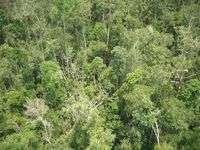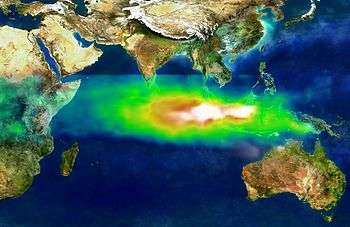Peat swamp forest

Peat swamp forests are tropical moist forests where waterlogged soil prevents dead leaves and wood from fully decomposing. Over time, this creates a thick layer of acidic peat. Large areas of these forests are being logged at high rates.
Peat swamp forests are typically surrounded by lowland rain forests on better-drained soils, and by brackish or salt-water mangrove forests near the coast.
Tropical peatlands, which coexist with swamp forests within the tropical and subtropical moist broadleaf forests biome, store and accumulate vast amounts of carbon as soil organic matter - much more than natural forests contain. Their stability has important implications for climate change; they are among the largest near-surface reserves of terrestrial organic carbon.[1] Unfortunately, peat swamp forests, which have ecological importance, are one of the most threatened, yet least studied and most poorly understood biotypes.
Since the 1970s, peat swamp forest deforestation and drainage have increased exponentially.[2] In addition, El Niño Southern Oscillation (ENSO) drought and large-scale fires are accelerating peatland devastation. This destruction enhances the decomposition of soil and organic matter, increasing the carbon release to the atmosphere as carbon dioxide. This phenomenon suggests that tropical peatlands have already become a large carbon-dioxide source, but related data and information is limited.[3]
Tropical peat swamp forests are home to thousands of animals and plants, including many rare and critically endangered species such as the orangutan and Sumatran tiger, whose habitats are threatened by peatland deforestation.[4]
Ecology

About 62% of the world’s tropical peat lands occur in the Indomalaya region (80% in Indonesia, 11% in Malaysia, 6% in Papua New Guinea, and pockets in Brunei, Vietnam, the Philippines, and Thailand.[5][6] They are unusual ecosystems, with trees up to 70 m high - vastly different from the peat lands of the north temperate and boreal zones (which are dominated by Sphagnum mosses, grasses, sedges and shrubs). The spongy, unstable, waterlogged, anaerobic beds of peat can be up to 20 m deep with low pH (pH 2.9 – 4) and low nutrients, and the forest floor is seasonally flooded.[7] The water is stained dark brown by the tannins that leach from the fallen leaves and peat – hence the name blackwater swamps. During the dry season, the peat remains waterlogged and pools remain among the trees.
In Indonesia
Peat formation is a natural carbon sink; carbon is withdrawn out of the system and converted into peat through biological activity. Peat swamp forests originally represented major ecosystems in Indonesia and ranged between 16.5–27 million hectares. In their original state, Indonesian peat swamp forests released between 0.01–0.03 Gt of carbon annually. In recent years, however, these important ecosystems have been reduced through deforestation, drainage, and conversion to agricultural lands and other activities. Their current status as carbon sequestering systems have thus also been reduced significantly. An understanding of the global importance of peat (and thus the urgency of maintaining peat swamp forests) and identifying alternative ways of making these areas productive in an environmentally sound and sustainable manner should have high priority among scientists and policy-makers alike.[8]
The Problem
-

Air pollution over Southeast Asia in October 1997.
-

Satellite photograph of the haze above Borneo
-

The lowlands to the north-west and south-east are shrouded with thick, grey smoke from dozens of fires in this satellite image from 2009.
Over the past decade, under the Mega Rice Project (MRP), the government of Indonesia has drained over 1 million hectares of the Borneo peat swamp forests for conversion to agricultural land. Between 1996 and 1998, more than 4,000 kilometers of drainage and irrigation channels were dug, and deforestation accelerated in part through legal and illegal logging and in part through burning. The water channels, and the roads and railways built for legal forestry, opened up the region to illegal forestry. In the MRP area, forest cover dropped from 64.8% in 1991 to 45.7% in 2000, and clearance has continued since then. It appears that almost all the marketable trees have now been removed from the areas covered by the MRP. What happened was not what had been expected: the channels drained the peat forests rather than irrigating them. Where the forests had often flooded up to 2 meters deep in the rainy season, now their surface is dry at all times of the year. The Indonesian government has now abandoned the MRP.
A study for the European Space Agency found that up to 2.57 billion tons of carbon were released to the atmosphere in 1997 as a result of burning peat and vegetation in Indonesia. This is equivalent to 40% of the average annual global carbon emissions from fossil fuels, and contributed greatly to the largest annual increase in atmospheric CO2 concentration detected since records began in 1957.[1] Additionally, the 2002-3 fires released between 200 million to 1 billion tons of carbon into the atmosphere.
Indonesia is currently the world's third largest carbon emitter, to a large extent due to the destruction of its ancient peat swamp forests.
Indonesia contains 50% of tropical peat swamps and 10% of dry land in the world. They have the potential of playing an important role in mitigating global warming and climate change under the reducing emissions from deforestation and forest degradation (REDD) scheme. Rather than reducing deforestation - in terms of claiming carbon credits from REDD initiatives - peatland conservation and rehabilitation are more efficient undertakings, due to the much larger reduced emissions achievable per unit area and the much lower opportunity costs involved.[9]
Conservation & Preservation
Attempts to preserve tropical peat swamp forests have been minimal in comparison to the widespread impact and devastation of commercial logging; in Sarawak, logging is ongoing and planned to intensify in Brunei. One plan by the environmental NGO Borneo Orangutan Survival is to preserve the peat swamp forest of Mawas using a combination of carbon finance and debt-for-nature-swap. About 6% of the original peat-forest area is contained within protected areas, the largest of which are Tanjung Puting and Sabangau National Parks.
The main causes of deforestation in Indonesia continue to be palm oil business (see palm oil production in Indonesia) and illegal logging, ongoing in areas such as South Sumatra. A survey by the University of Muhammadiyah Palembang in 2008 estimated that in 25 years most of the natural forests will be depleted due to illegal logging. Projects by REDD are designed to tackle deforestation and protect forests from the encroachment of agriculture, benefitting biodiversity and improving the quality of the environment to surrounding villages.[10]
To counter the destruction of mangroves and unsustainable palm oil expansion in Indonesia's peatlands, organizations, such as Wetlands International, work with the Indonesian government to improve policies and spatial planning. They engage with the palm-oil industry, promoting best management practices in tropical peat swamp forests and ensuring the participation of local communities, who lack awareness about natural resource management. In the field, they work with communities to restore mangroves and peatlands.
Habitat disturbance caused by logging was shown to affect orangutan density within a mixed swamp forest. The presence of a very large, self-sustaining orangutan population in this region emphasizes the urgency for greater protection of Kalimantan's peat swamp forests in light of recent and rapid habitat degradation.[3]
In Malaysia
It has long been assumed that the peat underlying tropical peat swamp forests accumulates because the extreme conditions (waterlogged, nutrient poor, anaerobic and acidic) impede microbial activity. Studies in a tropical Malaysian peat swamp (North Selangor peat swamp forest) showed that although the sclerophyllous, toxic leaves of endemic peat-forest plants (Macaranga pruinosa, Campnosperma coriaceum, Pandanus atrocarpus, Stenochlaena palustris) were barely decomposed by bacteria and fungi, the leaves of M. tanarius, another plant species, were almost completely decomposed after one year. Thus it is intrinsic properties of the leaves (that are adaptations to deter herbivory in the nutrient poor environment) that impede microbial breakdown.[11]
Ecoregions
- Borneo peat swamp forests (Brunei, Indonesia, Malaysia)
- Peninsular Malaysian peat swamp forests (Malaysia, Thailand)
- Ratargul Swamp Forest (Sylhet District, Bangladesh)
See also
- Bog
- Mega Rice Project (Kalimantan)
- 1997 Southeast Asian haze
- 2006 Southeast Asian haze
- Tropical peat
- Deforestation in Borneo
- Peninsular Malaysian peat swamp forests
- Social and environmental impact of palm oil
- Environmental issues in Indonesia
- The Burning Season
References
- 1 2 Paige, Susan E. (7 November 2002). The amount of carbon released from peat and forest fires in Indonesia during 1997.
- ↑ Ng, Peter. (June 1994). Diversity and conservation of blackwater fishes in Peninsular Malaysia, particularly in the North Selangor peat swamp forest
- 1 2 Hirano, Takashi. (29 November 2006). Carbon dioxide balance of a tropical peat swamp forest in Kalimantan, Indonesia.
- ↑ http://www.wetlands.org/Whatarewetlands/Peatlands/tabid/2737/Default.aspx
- ↑ Rieley JO, Ahmad-Shah AA Brady MA (1996) The extent and nature of tropical peat swamps. In: Maltby E, Immirzi CP, Safford RJ (eds) Tropical lowland peatlands of Southeast Asia, proceedings of a workshop on integrated planning and management of tropical lowland peatlands held at Cisarua, Indonesia, 3–8 July 1992. IUCN, Gland, Switzerland
- ↑ Page SE, Rieley JO, Wüst R (2006) Lowland tropical peatlands of Southeast Asia In: Martini IP, Martínez Cortizas A, Chesworth W (eds) Peatlands: Evolution and Records of Environmental and Climate Changes. Elsevier BV pp 145-172
- ↑ Yule CM (2008) Loss of biodiversity and ecosystem functioning in Indo-Malayan peat swamp forests. Biodiversity and Conservation doi:10.1007/s10531-008-9510-5
- ↑ Sorensen, Kim W. (September 1993). Indonesian peat swamp forests and their role as a carbon sink.
- ↑ Mathai, J. (5 October 2009). Seeing REDD over deforestation.
- ↑ Antara (news agency). (21 March 2011). RI`s peat forests can play important role in climate change.
- ↑ Yule, Catherine M. (22 June 2008). Leaf litter decomposition in a tropical peat swamp forest in Peninsular Malaysia.